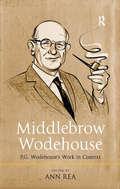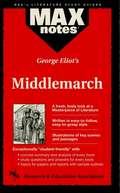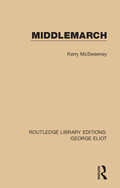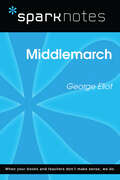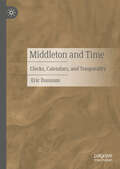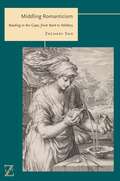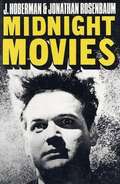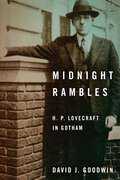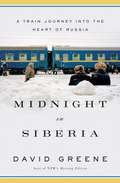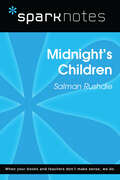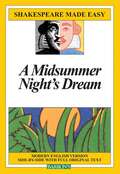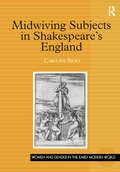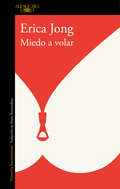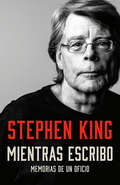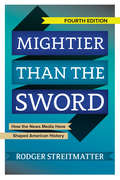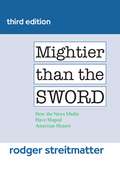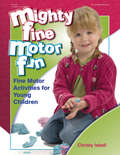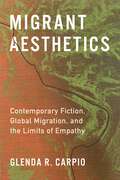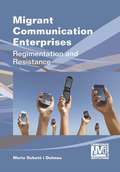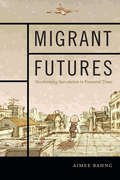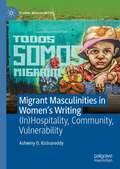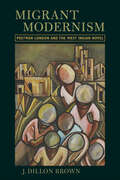- Table View
- List View
Middlebrow Queer: Christopher Isherwood in America
by Jaime HarkerHow could one write about gay life for the mainstream public in Cold War America? Many midcentury gay American writers, hampered by external and internal censors, never managed to do it. But Christopher Isherwood did, and what makes his accomplishment more remarkable is that while he was negotiating his identity as a gay writer, he was reinventing himself as an American one. Jaime Harker shows that Isherwood refashioned himself as an American writer following his emigration from England by immersing himself in the gay reading, writing, and publishing communities in Cold War America. Drawing extensively on Isherwood&’s archives, including manuscript drafts and unpublished correspondence with readers, publishers, and other writers, Middlebrow Queer demonstrates how Isherwood mainstreamed gay content for heterosexual readers in his postwar novels while also covertly writing for gay audiences and encouraging a symbiotic relationship between writer and reader. The result—in such novels as The World in the Evening, Down There on a Visit, A Single Man, and A Meeting by the River—was a complex, layered form of writing that Harker calls &“middlebrow camp,&” a mode that extended the boundaries of both gay and middlebrow fiction.Weaving together biography, history, and literary criticism, Middlebrow Queer traces the continuous evolution of Isherwood&’s simultaneously queer and American postwar authorial identity. In doing so, the book illuminates many aspects of Cold War America&’s gay print cultures, from gay protest novels to &“out&” pulp fiction.
Middlebrow Wodehouse: P.G. Wodehouse's Work in Context
by Ann ReaWhile he is best known for his Jeeves and Bertie Wooster stories, P.G. Wodehouse was a prolific writer who penned many other novels, stories, and musical comedy libretti, the latter of which played an enormous role in the development of American musical theater. This collection re-examines Wodehouse in the context of recent scholarship on the middlebrow, attending to his self-conscious relationship to the literary marketplace and his role in moving musical comedy away from vaudeville’s lowbrow associations towards the sophistication of the Wodehouse style. The focus on the middlebrow creates a critical context for serious critical consideration of Wodehouse’s linguistic playfulness and his depictions of social class within England. The contributors explore Wodehouse’s fiction and libretti in reference to philosophy, depictions of masculinity, World War I Britain, the periodical market, ideas of Englishness, and cultural phenomena such as men’s fashion, food culture, and popular songwriting. Taken together, the essays draw attention to the arbitrary divide between high- and middlebrow culture and make a case for Wodehouse as a writer whose games with language are in keeping with modernist experimentation with artistic expression.
Middlemarch (MAXNotes Literature Guides)
by Gail RaeREA's MAXnotes for George Eliot's Middlemarch MAXnotes offer a fresh look at masterpieces of literature, presented in a lively and interesting fashion. Written by literary experts who currently teach the subject, MAXnotes will enhance your understanding and enjoyment of the work. MAXnotes are designed to stimulate independent thought about the literary work by raising various issues and thought-provoking ideas and questions. MAXnotes cover the essentials of what one should know about each work, including an overall summary, character lists, an explanation and discussion of the plot, the work's historical context, illustrations to convey the mood of the work, and a biography of the author. Each chapter is individually summarized and analyzed, and has study questions and answers.
Middlemarch (Routledge Library Editions: George Eliot #5)
by Kerry McSweeneyFirst published in 1984. Although Middlemarch was extravagantly praised by Henry James, Emily Dickinson and Virginia Woolf, it is only in the last few decades that the novel has been widely recognised as George Eliot’s finest work, one of the greatest English novels, and one of the classic texts of nineteenth-century fiction. The intellectual, religious and aesthetic background to Middlemarch are fully examined, with particular attention paid to Eliot’s key doctrines of fellow-feeling and the humanistic economy of salvation. Professor McSweeney also provides fresh and thought-provoking discussions of the role of the omniscient narrator, and of character and characterisation. This title will be of interest to students of literature.
Middlemarch (SparkNotes Literature Guide Series)
by SparkNotesMiddlemarch (SparkNotes Literature Guide) by George Eliot Making the reading experience fun! Created by Harvard students for students everywhere, SparkNotes is a new breed of study guide: smarter, better, faster. Geared to what today's students need to know, SparkNotes provides: *Chapter-by-chapter analysis *Explanations of key themes, motifs, and symbols *A review quiz and essay topicsLively and accessible, these guides are perfect for late-night studying and writing papers
Middleton and Rowley
by David NicolCan the inadvertent clashes between collaborators produce more powerful effects than their concordances? For Thomas Middleton and William Rowley, the playwriting team best known for their tragedy The Changeling, disagreements and friction proved quite beneficial for their work.This first full-length study of Middleton and Rowley uses their plays to propose a new model for the study of collaborative authorship in early modern English drama. David Nicol highlights the diverse forms of collaborative relationships that factor into a play's meaning, including playwrights, actors, companies, playhouses, and patrons. This kaleidoscopic approach, which views the plays from all these perspectives, throws new light on the Middleton-Rowley oeuvre and on early modern dramatic collaboration as a whole.
Middleton and Time: Clocks, Calendars, and Temporality
by Eric DunnumA great deal has been written about early modern temporality, both by scholars of Renaissance drama and historians of chronometry. Much of the former has focused, unsurprisingly, on Shakespeare. This book seeks to broaden the discussion of temporality and the early modern stage by focusing on “our other Shakespeare” – Thomas Middleton, a writer preoccupied with issues of time, chronometry, and temporality. In this first book length study of Middleton’s portrayal of time, his representations of clocks and calendars are explored as a way of understanding early modern time consciousness. Middleton, more than any other playwright of his era, was aware of the alienating qualities of these chronometric devices and showed how the subject’s experience of time was influenced by them, while also demonstrating how choices in chronometry were influenced by gender, class and religious identity. As a result, his texts explore the complex intersections between sexuality, economic systems, and temporality in the early modern world.
Middling Romanticism: Reading in the Gaps, from Kant to Ashbery (Lit Z)
by Zachary SngRomanticism is often understood as an age of extremes, yet it also marks the birth of the modern medium in all senses of the word. Engaging with key texts of the romantic period, the book outlines a wide-reaching project to re-imagine the middle as a constitutive principle. Sng argues that Romanticism dislodges such terms as medium, moderation, and mediation from serving as mere self-evident tools that conduct from one pole to another. Instead, they offer a dwelling in and with the middle: an attention to intervals, interstices, and gaps that make these terms central to modern understandings of relation.
Midnight Movies
by J. Hoberman Jonathan RosenbaumMidnight Movies is a comprehensive and in-depth look at over 100 subculture movies of the past three decades. It discusses the complete history of cult films, their makers, and their audience and what keeps audiences coming back to see them over and over again.
Midnight Rambles: H. P. Lovecraft in Gotham
by David J. GoodwinA micro-biography of horror fiction’s most influential author and his love–hate relationship with New York City.By the end of his life and near financial ruin, pulp horror writer Howard Phillips Lovecraft resigned himself to the likelihood that his writing would be forgotten. Today, Lovecraft stands alongside J. R. R. Tolkien as the most influential genre writer of the twentieth century. His reputation as an unreformed racist and bigot, however, leaves readers to grapple with his legacy. Midnight Rambles explores Lovecraft’s time in New York City, a crucial yet often overlooked chapter in his life that shaped his literary career and the inextricable racism in his work. Initially, New York stood as a place of liberation for Lovecraft. During the brief period between 1924 and 1926 when he lived there, Lovecraft joined a creative community and experimented with bohemian living in the publishing and cultural capital of the United States. He also married fellow writer Sonia H. Greene, a Ukrainian-Jewish émigré in the fashion industry. However, cascading personal setbacks and his own professional ineptitude soured him on New York. As Lovecraft became more frustrated, his xenophobia and racism became more pronounced. New York’s large immigrant population and minority communities disgusted him, and this mindset soon became evident in his writing. Many of his stories from this era are infused with racial and ethnic stereotypes and nativist themes, most notably his overtly racist short story, “The Horror at Red Hook,” set in Red Hook, Brooklyn. His personal letters reveal an even darker bigotry.Author David J. Goodwin presents a chronological micro-biography of Lovecraft’s New York years, emphasizing Lovecraft’s exploration of the city environment, the greater metropolitan region, and other locales and how they molded him as a writer and as an individual. Drawing from primary sources (letters, memoirs, and published personal reflections) and secondary sources (biographies and scholarship), Midnight Rambles develops a portrait of a talented and troubled author and offers insights into his unsettling beliefs on race, ethnicity, and immigration.
Midnight in Siberia: A Train Journey Into the Heart of Russia
by David GreeneFar away from the trendy cafés, designer boutiques, and political protests and crackdowns in Moscow, the real Russia exists. Midnight in Siberia chronicles David Greene's journey on the Trans-Siberian Railway, a 6,000-mile cross-country trip from Moscow to the Pacific port of Vladivostok. In quadruple-bunked cabins and stopover towns sprinkled across the country's snowy landscape, Greene speaks with ordinary Russians about how their lives have changed in the post-Soviet years. These travels offer a glimpse of the new Russia--a nation that boasts open elections and newfound prosperity but continues to endure oppression, corruption, a dwindling population, and stark inequality. We follow Greene as he finds opportunity and hardship embodied in his fellow train travelers and in conversations with residents of towns throughout Siberia. We meet Nadezhda, an entrepreneur who runs a small hotel in Ishim, fighting through corrupt layers of bureaucracy every day. Greene spends a joyous evening with a group of babushkas who made international headlines as runners-up at the Eurovision singing competition. They sing Beatles covers, alongside their traditional songs, finding that music and companionship can heal wounds from the past. In Novosibirsk, Greene has tea with Alexei, who runs the carpet company his mother began after the Soviet collapse and has mixed feelings about a government in which his family has done quite well. And in Chelyabinsk, a hunt for space debris after a meteorite landing leads Greene to a young man orphaned as a teenager, forced into military service, and now figuring out if any of his dreams are possible. Midnight in Siberia is a lively travel narrative filled with humor, adventure, and insight. It opens a window onto that country's complicated relationship with democracy and offers a rare look into the soul of twenty-first-century Russia.
Midnight's Children (SparkNotes Literature Guide Series)
by SparkNotesMidnight's Children (SparkNotes Literature Guide) by Salman Rushdie Making the reading experience fun! Created by Harvard students for students everywhere, SparkNotes is a new breed of study guide: smarter, better, faster. Geared to what today's students need to know, SparkNotes provides: *Chapter-by-chapter analysis *Explanations of key themes, motifs, and symbols *A review quiz and essay topicsLively and accessible, these guides are perfect for late-night studying and writing papers
Midsummer Night's Dream (Shakespeare Made Easy)
by William ShakespeareA Simon & Schuster eBook. Simon & Schuster has a great book for every reader.
Midwiving Subjects in Shakespeare’s England (Women and Gender in the Early Modern World)
by Caroline BicksAt the intersections of early modern literature and history, Shakespeare and Women's Studies, Midwiving Subjects explores how Shakespearean drama and contemporary medical, religious and popular texts figured the midwife as a central producer of the body's cultural markers. In addition to attending most Englishwomen's births and testifying to their in extremis confessions about paternity, the midwife allegedly controlled the size of one's tongue and genitals at birth and was obligated to perform virginity exams, impotence tests and emergency baptisms. The signs of purity and masculinity, paternity and salvation were inherently open to interpretation, yet early modern culture authorized midwives to generate and announce them. Midwiving Subjects, then, challenges recent studies that read the midwife as a woman whose power was limited to a marginal and unruly birthroom community and instead uncovers the midwife's foundational role, not only in the rituals of reproduction, but in the process of cultural production itself. As a result of recent changes in managed healthcare and of increased attention to uncovering histories of women's experiences, midwives - past and present - are currently a subject of great interest. This book will appeal to readers interested in Shakespeare as well as the history of women and medicine.
Miedo a volar
by Erica JongCon más de veintisiete millones de ejemplares vendidos en todo el mundo desde su primera publicación en 1973, Miedo a volar es una novela revolucionaria considerada ya como un clásico de culto. Antes de Anastasia de Cincuenta sombras de Grey, Hannah de Girls y Carrie de Sexo en Nueva York, estaba Isadora Wing. Henry Miller dijo...«Este libro hará la historia de la literatura. Gracias a él las mujeres van a encontrar su propia voz y a darnos grandes sagas sobre el sexo, la vida, la alegría, y la aventura.» Soñadora compulsiva, acosadora de psiquiatras y autora de poemas eróticos, Isadora Wing tiene fobia a volar, pero no va a permitir que el miedo le impida subirse a un avión. Durante un viaje a Viena para asistir a un congreso sobre psicoanálisis junto a su marido psiquiatra, conoce a un desinhibido analista que parece la encarnación de su ideal erótico. Ese encuentro le permitirá alejarse de su marido para emprender una búsqueda de su propia forma de liberación. En los efervescentes años setenta, Miedo a volar alimentó las fantasías y encendió los debates sobre las mujeres y el sexo en medio mundo. Hoy las aventuras y desventuras eróticas de la protagonista, narradas con un ingenio, exuberancia y sinceridad que durante siglos solo se les permitió a los hombres, se han convertido en el icono literario de la liberación de la mujer. Críticas:«Miedo a volar tiene clase y descaro, brillo y sarcasmo. Además de erigirse como un florecimiento de lo más brillante y exuberante en el sediento jardín del "despertar" de la conciencia femenina, pertenece y prolonga de manera hilarante la tradición de El guardián entre el centeno y El lamento de Potnoy.»John Updike, The New Yorker «Trasciende el hecho de ser un libro de una mujer y se convierte en un contemporáneo Ulises, con un Harold Bloom mujer que tropieza y anda a tientas, pero que sobrevive.»The Wall Street Journal «Extraordinaria. Tremendamente divertida y muy sabia a la vez.»Los Angeles Times «Una aventura picaresca, divertida y conmovedora la de Isadora Wing, que huye de su marido psicoanalista y se lanza en busca de la alegría y de su yo verdadero.»New York Review of Books «Este libro hará la historia de la literatura. Gracias a él las mujeres van a encontrar su propia voz y a darnos grandes sagas sobre el sexo, la vida, la alegría, y la aventura.»Henry Miller
Mientras escribo (Bestseller/debolsillo Ser. #Vol. 102)
by Stephen KingPocas veces un libro sobre el oficio de escribir ha resultado tan clarificador, útil y revelador. Cuando Stephen King se decidió a escribir sobre su profesión y su vida, un brutal accidente automovilístico puso ambas en riesgo. Durante su convalecencia, el novelista descubrió los vínculos cada vez más fuertes entre la escritura y la vida. Y el resultado es este extraordinario libro, que es al mismo tiempo un ensayo sobre creación literaria y un relato autobiográfico. Mientras escribo comienza con la asombrosa infancia de Stephen King y su extraño y temprano interés por la escritura que lo llevaron a la culminación de su primera novela, Carrie. A continuación, King describe las herramientas básicas del oficio y expone sus opiniones personales sobre los secretos de la escritura. Mientras escribo culmina con el conmovedor relato de cómo su necesidad de escribir lo ayudó a recuperarse de su casi fatal accidente. Una vez más Stephen King demuestra que es mucho más que unmaestro del thriller: un gran escritor.
Mightier than the Sword
by Rodger StreitmatterIn this text for an undergraduate course in history and/or journalism, Streitmatter (journalism, American University) examines 16 major milestones in US history which shed light on how events have been influenced by the news media, from the Revolutionary War era to the present, in areas such as women's rights, civil rights, and public opinion on war. There is also discussion of Watergate, Rush Limbaugh, and the media's response to the terrorist attacks on 9/11. While several chapters focus on examples of the negative impact of the media, most describe its positive impact. This third edition contains a new chapter on Obama's election and offers new material on social media and Internet news outlets. The book includes b&w historical illustrations and photos. It is accessible to general readers as well as students. Annotation ©2012 Book News, Inc. , Portland, OR (booknews. com)
Mightier than the Sword
by Rodger StreitmatterIn this path-breaking book, Rodger Streitmatter takes readers on a sightseeing tour of American history as influenced by the public press, visiting sixteen landmark events in US history, from the American Revolution and the civil rights movement to Watergate and 9/11. These are events that stir the political imagination; but, as Streitmatter shows, they also demonstrate how American journalism, since the 1760s, has not merely recorded this nation’s history but has played a role in shaping it. This book is the first of its kind. Streitmatter avoids the mind-numbing lists of names, dates, and newspaper headlines that bog down the standard journalism history textbook. Instead, he focuses on a limited number of episodes, identifying common characteristics within the news media. The third edition includes an entirely new chapter on social media and the election of Barack Obama. This edition also looks beyond traditional journalistic outlets such as newspapers and television news reports to examine the modern-day role that the Internet and its various venues play in reporting the news and shaping history.
Mightier than the Sword
by Rodger StreitmatterIn this engaging examination of the media’s influence on US history and politics, Rodger Streitmatter visits sixteen landmark episodes, from the American Revolution to the present-day fight for gay and lesbian marriage equality. In each of these cases, Streitmatter succinctly illustrates the enormous role that journalism has played in not merely recording this nation’s history but also in actively shaping it. Mightier than the Sword offers students and professors a highly readable and accessible alternative to journalism history textbooks. Instead of trying to document every detail in the development of US media through dry, dull lists of names, dates, and headlines, this book focuses on sixteen discrete episodes that illustrate a point that is much larger than the sum of their parts: media have played and continue to play an enormous role in shaping this nation. The fourth edition features an entirely new chapter on the way US media have championed various gay and lesbian rights initiatives, from the 2003 Lawrence vs. Texas sodomy case through the June 2013 Supreme Court decision striking down DOMA (the Defense of Marriage Act). Balancing criticism and celebration of news media and exploring both print and electronic platforms, Mightier than the Sword provides students with a sense of the power and responsibility inherent in the institution of journalism.
Mighty Fine Motor Fun: Fine Motor Activities for Young Children
by Christy IsbellFun activities to develop the fine motor skills preschoolers need for school success!Teachers know how important it is to develop children's fine motor skills as a stepping stone to future learning, and Mighty Fine Motor Fun provides you with the tools and information you need to teach fine motor skills to children ages 3 to 5. The activities in Mighty Fine Motor Fun are organized by age; they are useful and creative, but most important, they are fun! With few materials needed, the activities are perfect for both large and small groups and are easy to integrate into any curriculum.Activities include:* Moving Bubbles * Hide-and-Seek Playdough * Tape It Up! * Shape Person* Itsy Bitsy Writing Utensils* Paper Mobile * And many more!In the final chapter of the book, author and occupational therapist Christy Isbell answers questions from real preschool teachers, including: * Should preschoolers use "fat" or "skinny" pencils? * What type of paper is best for cutting? * When should a child use an adult-like grasp of the pencil? Teachers will appreciate the practical, real-world knowledge Isbell offers, and children will love the playful, absorbing activities!
Migrant Aesthetics: Contemporary Fiction, Global Migration, and the Limits of Empathy (Literature Now)
by Glenda R. CarpioBy most accounts, immigrant literature deals primarily with how immigrants struggle to adapt to their adopted countries. Its readers have come to expect stories of identity formation, of how immigrants create ethnic communities and maintain ties to countries of origin. Yet such narratives can center exceptional stories of individual success or obscure the political forces that uproot millions of people the world over.Glenda R. Carpio argues that we need a new paradigm for migrant fiction. Migrant Aesthetics shows how contemporary authors—Teju Cole, Dinaw Mengestu, Aleksandar Hemon, Valeria Luiselli, Julie Otsuka, and Junot Díaz—expose the historical legacies and political injustices that produce forced migration through artistic innovation. Their fiction rejects the generic features of immigrant literature—especially the acculturation plot and the use of migrant narrators as cultural guides who must appeal to readerly empathy. They emphasize the limits of empathy, insisting instead that readers recognize their own roles in the realities of migration, which, like climate change, is driven by global inequalities. Carpio traces how these authors create literary echoes of the past, showing how the history of (neo)colonialism links distinct immigrant experiences and can lay the foundation for cross-ethnic migrant solidarity. Revealing how migration shapes and is shaped by language and narrative, Migrant Aesthetics casts fiction as vital testimony to past and present colonial, imperial, and structural displacement and violence.
Migrant Communication Enterprises
by Maria Sabaté i DalmauThis unique critical sociolinguistic ethnography explores alternative migrant-regulated institutions of resistance and subversive communication technology: the locutorios or ethnic call shops. These migrant-owned businesses act as a window into their multimodal and hybrid linguistic and communicative practices, and into their own linguistic hierarchies and non-mainstream sociolinguistic orders. Here, socially displaced but technologically empowered transnational migrant populations actively find subversive ways to access information and communication technologies. As such they mobilise their own resources to successfully inhabit Catalonia, at the margins of powerful institutions. The book also focuses on the (internal) social organisation dynamics, as well as on the simultaneous fight against, and re-production of, practices and processes of social difference and social inequality among migrants themselves.
Migrant Futures: Decolonizing Speculation in Financial Times
by Aimee BahngIn Migrant Futures Aimee Bahng traces the cultural production of futurity by juxtaposing the practices of speculative finance against those of speculative fiction. While financial speculation creates a future based on predicting and mitigating risk for wealthy elites, the wide range of speculative novels, comics, films, and narratives Bahng examines imagines alternative futures that envision the multiple possibilities that exist beyond capital’s reach. Whether presenting new spatial futures of the US-Mexico borderlands or inventing forms of kinship in Singapore in order to survive in an economy designed for the few, the varied texts Bahng analyzes illuminate how the futurity of speculative finance is experienced by those who find themselves mired in it. At the same time these displaced, undocumented, unbanked, and disavowed characters imagine alternative visions of the future that offer ways to bring forth new political economies, social structures, and subjectivities that exceed the framework of capitalism.
Migrant Masculinities in Women’s Writing: (In)Hospitality, Community, Vulnerability (Global Masculinities)
by Ashwiny O. KistnareddyThis book examines the representation of masculinities in contemporary texts written by women who have immigrated into France or Canada from a range of geographical spaces. Exploring works by Léonora Miano (Cameroon), Fatou Diome (Senegal), Assia Djebar, Malika Mokeddem (Algeria), Ananda Devi (Mauritius), Ying Chen (China) and Kim Thúy (Vietnam), this study charts the extent to which migration generates new ways of understanding and writing masculinities. It draws on diverse theoretical perspectives, including postcolonial theory, affect theory and critical race theory, while bringing visibility to the many women across various historical and geographical terrains who write about (im)migration and the impact on men, even as these women, too, acquire a different position in the new society.
Migrant Modernism: Postwar London and the West Indian Novel
by J. Dillon BrownIn Migrant Modernism, J. Dillon Brown examines the intersection between British literary modernism and the foundational West Indian novels that emerged in London after World War II. By emphasizing the location in which anglophone Caribbean writers such as George Lamming, V. S. Naipaul, and Samuel Selvon produced and published their work, Brown reveals a dynamic convergence between modernism and postcolonial literature that has often been ignored. Modernist techniques not only provided a way for these writers to mark their difference from the aggressively English, literalist aesthetic that dominated postwar literature in London but also served as a self-critical medium through which to treat themes of nationalism, cultural inheritance, and identity.

